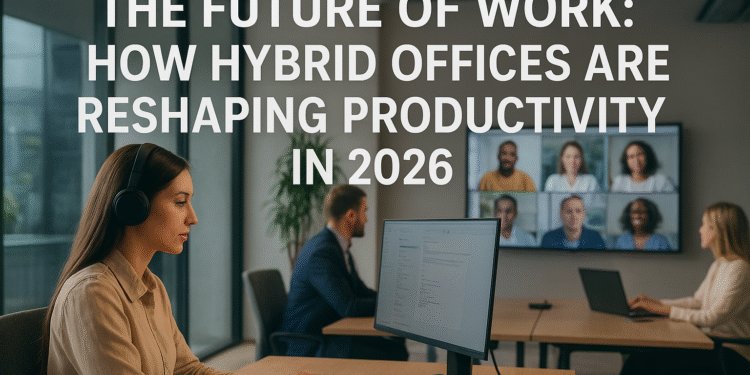
The pandemic didn’t just change where we work — it completely redefined how we work. Fast forward to 2026, and hybrid work models have evolved from temporary experiments into long-term strategies. Across the United States, companies are finding new ways to balance flexibility with productivity, blending remote convenience with the collaboration of office culture.
Today’s hybrid offices aren’t just about alternating days at home and the workplace. They’re about creating a seamless, digital-first ecosystem that enhances employee engagement, innovation, and performance — no matter where work happens.
What Is a Hybrid Office in 2026?
A hybrid office is more than a physical space — it’s a philosophy of work.
In 2026, hybrid models have matured with the help of advanced tools like AI-powered scheduling, smart office design, and real-time performance analytics.
Here’s what defines the modern hybrid workplace:
-
Flexibility first: Employees choose where and when they’re most productive.
-
Smart collaboration: Digital whiteboards, VR meeting rooms, and unified communication apps connect teams seamlessly.
-
Outcome over hours: Success is measured by results, not attendance.
-
Well-being at the core: Offices are designed to support mental health, creativity, and balance.
The Productivity Shift: Numbers Don’t Lie
Recent studies by Gartner and Microsoft Work Trend Index 2025 show that hybrid employees report 20–30% higher productivity compared to traditional in-office workers. Why?
-
Reduced burnout: Employees gain control over their time and environment.
-
Fewer distractions: Remote days allow deep focus work.
-
Better collaboration tools: Cloud platforms and AI assistants eliminate friction.
-
Increased inclusivity: Companies tap into talent beyond their physical locations.
In short, hybrid models let employees work smarter, not harder — and businesses are reaping the rewards in engagement and retention.
How Companies Are Redefining “Office”
Forward-thinking U.S. companies like Google, Salesforce, and HubSpot are setting the tone:
-
Google uses “collaboration days” to bring teams together for creativity and innovation.
-
Salesforce redesigned its offices as “collaboration hubs” with flexible layouts and fewer cubicles.
-
HubSpot allows employees to choose their preferred work style: home, hybrid, or office.
These companies have learned that the office isn’t disappearing — it’s evolving into a dynamic, experience-driven space.
The Role of Technology
Tech innovation is the backbone of the hybrid revolution.
In 2026, offices integrate AI-driven systems that optimize space usage, energy consumption, and employee scheduling. Tools like:
-
AI-powered assistants for meeting summaries and task follow-ups.
-
Digital twins of office spaces for real-time occupancy data.
-
Augmented reality (AR) meetings for immersive collaboration.
The result? A workplace that’s not just smart — but adaptive.
Human Connection Still Matters
Even in a tech-driven world, the human element remains irreplaceable.
Hybrid models succeed when they foster belonging and purpose. Leading companies now focus on:
-
Hosting monthly in-person team days for bonding.
-
Creating virtual watercooler moments via chat platforms.
-
Supporting employee wellness through mental health programs and flexible hours.
When employees feel connected, productivity follows naturally.
The Future Outlook
By 2026 and beyond, hybrid offices will continue to evolve around three pillars:
-
Flexibility: Work adapts to life, not the other way around.
-
Technology: AI and automation simplify daily workflows.
-
Culture: Empathy and inclusion drive team engagement.
The future workplace won’t be defined by walls or desks — but by connection, choice, and creativity.
The shift toward hybrid work isn’t just a trend; it’s a transformation of how we define success in the workplace.
For U.S. companies, the challenge isn’t deciding if hybrid work is the future — it’s figuring out how to make it sustainable, equitable, and inspiring.
The future of work is already here — and it’s hybrid, human, and hopeful.

